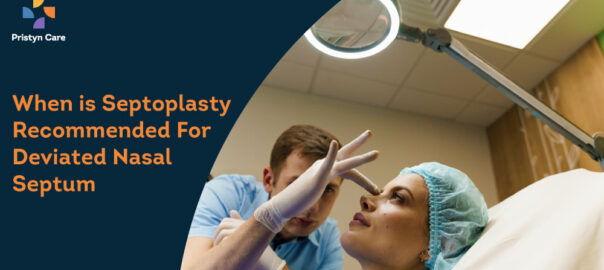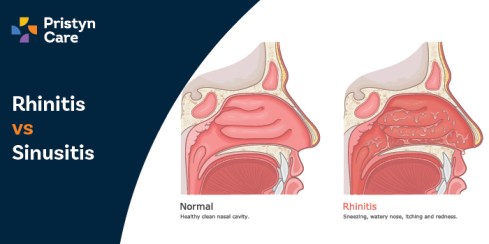![]() Views: 36,410
Views: 36,410
Does Septoplasty Change Appearance Of the Nose and Other 9 FAQs
“Will Septoplasty change the appearance of my nose?” is a common question that a lot of ENT specialists come across. People fear that the surgery may change the shape of the nose which in turn may change the overall look of their face. In fear of changing their facial appearance, they refuse to undergo ...
https://www.pristyncare.com/disease/deviated-nasal-septum/">septoplasty. Read moreWell, they fail to see the bigger picture that severe deviation can result in functional problems of the nose. .
Dedicated Support at Every Step!
Our Doctors are available 24 hours a day, 7 days a week to help you!
Here is a list of 10 FAQs that can clarify some of the doubts that people may have before septoplasty.
Table of Contents
FAQ1: What is Septoplasty?
The surgical procedure to straighten a deviated septum is known as septoplasty. A deviated septum is the one that develops when part of the septum deviates towards one side of the nasal passages. Commonly people refer to deviated septum as a crooked nose.
The deviated septum makes it difficult for a person to breathe as there is an uneven airflow that enters the nasal passages. The situation gets worse when the individual is suffering from an upper respiratory infection and sinusitis.
Also Read: Endoscopic Septoplasty: Procedure, Benefits and Cost
No Cost EMI, Hassle-free Insurance Approval
FAQ2: Who should consider Septoplasty?
People suffering from any of the following conditions should consider undergoing Septoplasty-
- Blockage in one or both the nostrils- Due to shifting of the septum towards one side of the nostril, it creates a blockage in one or both the nostrils. The individual is unable to breathe openly as the nostrils don’t allow air to enter.
- Frequent episodes of sinusitis and blocked nose- As less air enters the nostrils, there are more chances of sinus infections and post-nasal drip.
- High risk of nosebleeds- The dryness of the nose increases the likelihood of nosebleeds.
- Unable to sleep properly- Due to severe nasal congestion, the person may have uninterrupted sleep. This results in breathing through the mouth which can lead to dryness of the mouth.
FAQ3: What is the difference between Septoplasty and Rhinoplasty?
People often confuse between Septoplasty and Rhinoplasty as both of these are types of nasal surgeries. Both of them are separate procedures and prescribed for different reasons.
| Septoplasty | Rhinoplasty |
| Corrects the deviation of the septum which is responsible for other nasal issues. | Cures nasal problems as well as enhances the appearance of the nose. |
| The doctor doesn’t touch the external shape. | The surgery aims to change the overall shape of the nose. |
| Simply straightens the septum inside the nose. | Reshapes the nose according to its size, symmetry and shape. |
Also Read: Difference between Submucosal Resection and Septoplasty
FAQ4: What is the procedure of Septoplasty?
Here is a step-by-step procedure of Septoplasty-
Step 1- Administering anesthesia
An anesthetist checks the patient thoroughly to ensure if there is going to be any risks after administering the anesthesia. The anesthetists administer general or local anesthesia through an intravenous channel or injection.
Step 2- Making incisions
After making sure that the person is completely unconscious, the doctor makes several incisions. An expert in septoplasty makes incisions where there will be negligible scarring. Generally, the ENT doctor makes an incision across the columella which is a tissue that separates both the nostrils.
Step 3- Separating mucosal lining
Through the incision, the doctor accesses the mucosal lining that covers over the septum. Then the doctor lifts the lining from one side of the septum. This is a very important step as any damage to the lining can result in a hole in the mucosal lining. The doctor repeats this from the opposite side.
Step 4- Correcting the deviated septum
After lifting up the deviated septum, the doctor straightens the septum to correct the deviation. Following this step, the doctor repositions the mucosal lining.
Step 5- Closing the incision with stitches
The doctor then replaces the mucosal lining and stitches it with dissolvable sutures. Nasal packing is placed inside the nose to prevent nosebleeds. It also stabilizes the nose from moving.
First-Hand Experience of A Patient Going Septoplasty from Pristyn Care
FAQ5: How to prepare for Septoplasty?
Preparation is an essential element for Septoplasty. It helps to minimize the risk of infections and postoperative bleeding. After a physical examination, the doctor may recommend some diagnostic tests that the patient has to undergo. These diagnostic tests include some blood tests and MRIs.
In addition to this, the doctor may ask you to avoid taking some medicines such as aspirin as these can make the blood thin. The patient has to stop smoking or drinking alcohol before the surgery. Moreover, supplements or herbal remedies can also interact. Let your doctor know about the same.
FAQ6: How long does it take to fully recover after Septoplasty?
Once the Septoplasty procedure is complete, the person can resume their daily activities within two days. However, it is better to consult with the doctor first before resuming work. The complete recovery period of septoplasty depends on the extent of the deviation, the technique used, and the patient’s healing capabilities. For instance, a patient is likely to recover faster if he undergoes an endoscopic septoplasty than conventional septoplasty. In normal circumstances, the patient usually takes about 7 days to recover completely. In some cases, it can take a couple of days extra.
FAQ7: What are some postoperative instructions to follow after Septoplasty?
Once the surgery is complete, it is normal to feel mild pain and nasal congestion. Fortunately, these subside on their own and the patient is able to breathe freely within a couple of days.
The instructions given by the ENT doctor are for the following purposes-
- How to take care of the wounds and scars after the surgery
- Which medicines to apply around the surgical site or to take orally to reduce pain and risk of infection
- What kind of particular diet to follow for speeding up the healing
- When to visit the doctor for a follow-up
Here is a checklist of Dos and Don’ts that doctors provide during the discharge and ask the patients to follow judiciously for fast recovery.
| Do’s | Don’ts |
| Rest completely for the initial 24 hours of the recovery. | Do not touch or rub the nose even by mistake. |
| Sneeze through the mouth instead of the nose. | Avoid blowing the nose as much as possible to reduce the risk of bleeding. |
| Apply an ice or cool gel pack around the incision site to minimize pain and swelling. | Restrict strenuous activities that can cause some side effects such as bending or playing any sports. |
| While sleeping at night, put two pillows under the head. | Do not lie flat on the back in the initial days of recovery. |
| Stay indoors as much as possible to prevent an infection. | Stop visiting places that are dusty or smoky. |
| Take shower only after proper consultation with the doctor. | Do not strain excessively or put pressure on the face unnecessarily. |
Also Read: Aftercare of Septoplasty
FAQ8: What are some possible side effects that can occur after Septoplasty?
It is important for patients to know the possible risks and complications of septoplasty so that they can decide whether to undergo the surgery. Pristyn Care ENT specialists explain the possible complications to look out for prior to the surgery. These are some of the side effects that can occur but there can be other too-
- Risk of infection around the incision site
- Possible chances of nose bleeding
- Hole in the septum
- Loss of sense of taste and smell
- Temporary numbness of the upper jaw
- Hoarseness of voice
- Bruising and pain around the face
- Swelling around the eyes
- Spinal fluid leakage
- Risks due to anesthesia
- Continuation of previous symptoms even after the surgery
- Undesired change in the shape of the nose
- Collection of blood in nasal passages also known as septal hematoma
- Toxic shock syndrome
FAQ9: Does septoplasty change the appearance of the nose?
Yes, septoplasty changes and enhances the appearance of the nose. The nasal septum plays a major role in determining the shape and form of the nose. It also helps to determine the height and width of the nose.
Hence, any change in the nasal septum will automatically affect the overall appearance of the nose.
Most of the people choose to undergo septoplasty to primarily change the nose appearance. When the doctor fixes the deviation of the septum, the nose form also changes, majorly making it more symmetrical. In addition to this, the straightening of the nose removes any blockage allowing the person to breathe freely.
Also Read: Nose Before and After Septoplasty
FAQ10: Will insurance cover my septoplasty?
Yes, most of the health insurance plans cover the cost of septoplasty. As deviated septum is considered as a cause for medical conditions such as chronic sinusitis and sleep apnea, it is considered as a medical procedure. Hence, several insurance plans cover septoplasty. The cost of septoplasty also includes the hospitalization charge as well as anesthesia fees. However, it may not cover the prescribed medicines.
Also Read: Nose Surgery and Its Cost in India
Conclusion
The above 10 Frequently Asked Questions can help you decide whether septoplasty is suitable for you or not. In case you have more questions related to septoplasty, consult with ENT Specialists from Pristyn Care who are highly specialized in treating various ENT illnesses. Book an online appointment without any further delay to know more.
Read More:
- Difference Between Septoplasty and Turbinoplasty
- Rhinoplasty Surgery: Purpose, Procedure, Benefits and Risks










